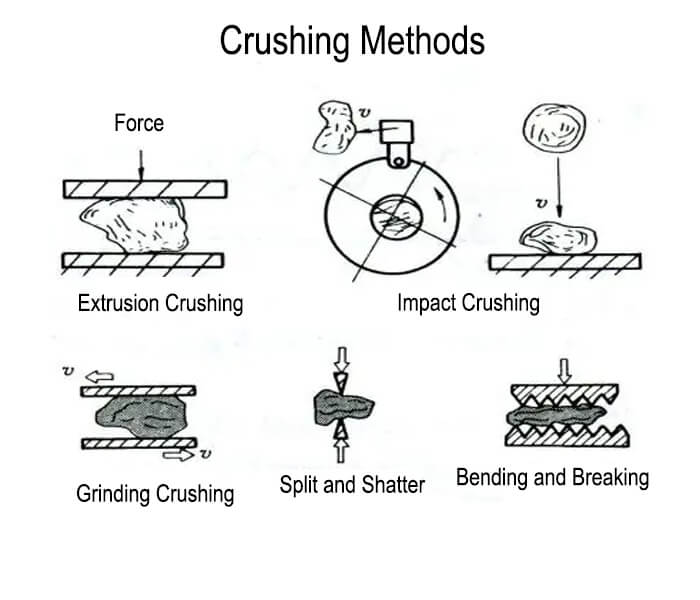As a newcomer to the beneficiation industry, there will be a lot of knowledge to learn. Beneficiation is a significant science, including mineral processing methods, technologies, equipment, and beneficiation solutions. In this process, we will encounter common questions and answers about beneficiation. As a professional mining equipment manufacturer and mineral ores solution supplier, JXSC summarizes some common questions and answers for your reference. Today we will introduce 11 FAQs about rock and mineral.
FAQs About Rock & Mineral
1. What is the role of crushing in the beneficiation process?
Answer: The crushing of ore refers to separating useful minerals in the ore, which is a prerequisite for beneficiation.
2. How many stages is the crushing operation generally divided into?
Answer: Coarse, medium, fine
3. What kind of crusher is suitable for ore-crushing operation?
Answer: Choosing a suitable crusher for ore crushing depends on the type of ore, its hardness, the desired product size, and other factors. Here are some common types of crushers used in ore-crushing operations:
- Jaw Crusher
Application: Primary crushing of hard materials, including ores and minerals.
Advantages: Simple structure, reliable operation, and relatively low cost.
Considerations: It may not be suitable for all types of ores, especially those with high abrasiveness.
- Gyratory Crusher
Application: Primary or secondary hard, tough, and abrasive materials crushing.
Advantages: High capacity, continuous operation, and good product shape.
Considerations: Higher initial cost compared to jaw crushers.
- Cone Crusher
Application: Secondary and tertiary crushing of various ores and rocks.
Advantages: Good product shape, large crushing ratio, and efficient operation.
Considerations: Initial cost, maintenance, and the need for regular calibration.
- Impact Crusher
Application: Primary and secondary crushing of soft to medium-hard ores and materials.
Advantages: High reduction ratio, good particle shape, and versatile applications.
Considerations: It may not be suitable for very hard or abrasive materials.
- Roll Crusher
Application: Primary, secondary, and tertiary crushing of friable materials.
Advantages: Compact design, easy maintenance, and relatively low cost.
Considerations: Limited capacity and not suitable for hard or abrasive materials.
- Hammer Crusher
Application: Primary and secondary crushing of brittle materials.
Advantages: Simple structure, high reduction ratio, and low operating costs.
Considerations: Not suitable for hard or abrasive ores.
- Vertical Shaft Impact (VSI) Crusher
Application: Crushing of ores to produce manufactured sand and cubical aggregates.
Advantages: Good product shape, high reduction ratio, and selective crushing.
Considerations: Specific to certain types of ores, and unsuitable for all applications.
The choice of crusher also depends on the specific requirements of the ore processing plant, such as the desired product size, production capacity, and the characteristics of the ore. It’s essential to thoroughly analyze the ore properties and operational requirements before selecting a crusher for a particular ore-crushing operation. Consulting with experienced engineers or experts in mineral processing can also be valuable in making the right decision.
4. What are the standard crushing methods?
Answer: Crushing method: At present, the crushing of ore mainly relies on the action of mechanical force. The most common ones are as follows:
(1) Crushing method: Two crushing working surfaces are used to pressurize the material to crush the material. The characteristic of this method is that the force increases gradually, and the force has a larger range of action.
(2) Splitting method: Uses the splitting force of the tines to wedge the material to break the material, which is characterized by a concentrated range of force and local rupture.
(3) Breaking method: When the material is broken, the material is broken due to the bending force being concentrated in the opposite direction; under the action of bending force, it is easy to break the ore.
(4) Grinding and peeling method: The crushing working surface moves relatively on the material, generating shearing force. This force acts on the ore surface and is suitable for grinding fine materials.
(5) Impact method: The crushing force acts on the material instantaneously, so it is also called dynamic crushing.

The currently used crushing machines often have a combination of several crushing methods for the crushing of ore.
5. What are the types of screening operations?
Answer: It can divide screening operations into five categories depending on the purpose of screening. They are independent screening, auxiliary screening, preparation screening, selective screening, and dehydration screening.
6. What are the factors that affect the screening operation?
Answer: The physical properties of the material to be screened, the properties of the screen surface and its structural parameters, and the impact of production conditions.
7. What is the screening efficiency?
Answer: The screening efficiency is an indicator of the working quality of the screen. It indicates the degree of sieving operation and the quality of sieved products. The sieving efficiency is usually calculated by the rate, which is the weight of the product under the sieve and the weight of particle size smaller than the sieve size contained in the raw material.
8. How can we use the “equivalent screening” working system to improve the production capacity of the sieve?
Answer: The sieving process is unbalanced, “difficult-to-sieve particles pass slowly through the sieve holes, and fine particles pass through the sieve holes quickly. Due to this imbalance, the sieve can be improved by increasing the size of the sieve holes and reducing the sieving efficiency.
9. What are the categories of screening machinery?
Answer: According to the structure and working principle of the screening machinery, it can divide the screening machinery into the following categories: fixed screen, roller screen, cylindrical screen, plane moving screen
10. What are the main advantages of a vibrating screen?
Answer: The vibrating screen has the advantages of not being easy to play, high productivity, high screening efficiency, simple structure, and fewer metal materials consumed during manufacture. It can also use a vibrating screen for dehydration and desliming operations.
11. What are the types of vibrating screens?
Answer: Eccentric vibrating screen, inertia vibrating screen, self-centering vibrating screen, resonance screen.
